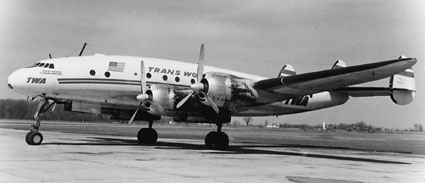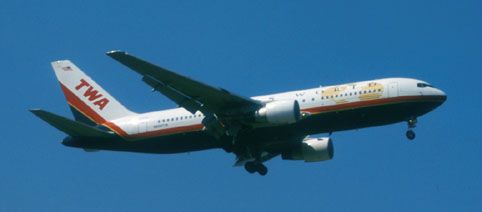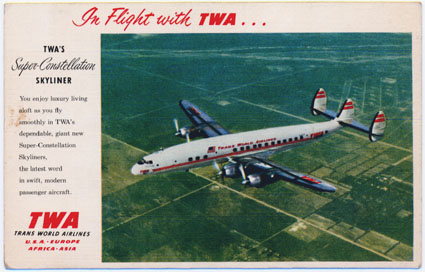
The Italian Aerospace Information Web
by Aeromedia - corso Giambone 46/18 - 10135 Torino (Italy)
TWA Quits Italy
 Beginning 2000 TWA ceased its flights to Rome. Beginning 2001 the daily JFK-Milan/Malpensa service was also canceled from the US carrier network, ending TWA 54 years long presence in Italy.
Beginning 2000 TWA ceased its flights to Rome. Beginning 2001 the daily JFK-Milan/Malpensa service was also canceled from the US carrier network, ending TWA 54 years long presence in Italy.
For the history of the air transport in Italy, the move, decided by TWA inside a general reduction of the North Atlantic activity, is something more than a normal route-restructuring of a foreign carrier.
Some months after the end of WW2, beginning 1946, Transcontinental & Western Air (the then full name of TWA) started a series of transatlantic services from New York to, Paris, Madrid, Lisbon and Rome.
The first of 21 Lockheed 049 Constellations was delivered to TWA just November 1945. The unmistakable shape of the Connie became a very familiar sight in the Italian skies. Two years later TWA put in service the first extended range variant Model 649.
During the early fifties, transatlantic flights needed intermediate fuel stops in remote airports like Gander (Newfoundland/Canada) and Shannon (Ireland). The progress of aviation was steady and more evident to customers than today and every gain in airliner range was much welcome by the passengers.
 TWA not only operated its own flights from US to Italy but it cooperated to set up LAI - Linee Aeree Italiane, an international airline based in Rome which later merged with Alitalia.
TWA not only operated its own flights from US to Italy but it cooperated to set up LAI - Linee Aeree Italiane, an international airline based in Rome which later merged with Alitalia.
The US airline was enjoying an absolute dominant position in the most lucrative North-Atlantic routes when, 17 May 1950, it took its present name Trans World Airlines.
Some competitors put in service successive models of the Douglas four engined liners but TWA remained loyal to Lockheed and, mid 1957, received the first of 57 enhanced Model 1049 Super Constellations, renamed as "Jetstream" by TWA, as usual practice by major airlines.
Two years later, when the average fleet of an European flag airline totals 20/30 aircraft, TWA launches over the Atlantic Ocean a daily flow of 146 Constellations, of all versions, comprising the ultimate but, by that time, outdated Model 1649 Starliner, able anyway to fly non-stop from Los Angeles to London.
But 1959 was also the start of the transition of air transport to jet propulsion. TWA, as the largest world airline, was an obvious launch customer for the new Boeing B.707.
 During the following two decades, the US carrier grew steadily, drawing up an intercontinental fleet formed by about one hundred B.707s "Starstream". They were later flanked and replaced by lesser quantities of B.747s and Lockheed L-1011 TriStars. In this period Boeing B.727 is the work-horse of TWA domestic network.
During the following two decades, the US carrier grew steadily, drawing up an intercontinental fleet formed by about one hundred B.707s "Starstream". They were later flanked and replaced by lesser quantities of B.747s and Lockheed L-1011 TriStars. In this period Boeing B.727 is the work-horse of TWA domestic network.
The Reagan's air transport deregulation and subsequent heavy competition badly affected the TWA premiership on the Atlantic routes. The US airline restructured itself as a medium size domestic/international carrier, reducing its long-range fleet to an handful of Boeing B.767s.
In the pictures: The first and the last aircraft type used by TWA for its Italian services; Lockheed Model 749 Constellation N91201 "Star of Portugal" and Boeing B.767-205ER N650TW. Trans World Airlines promotional postcard distributed as courtesy copy, from 1957, on board the TWA Lockheed Model 1049 Super Constellations.
(Aeromedia, January 2001)


